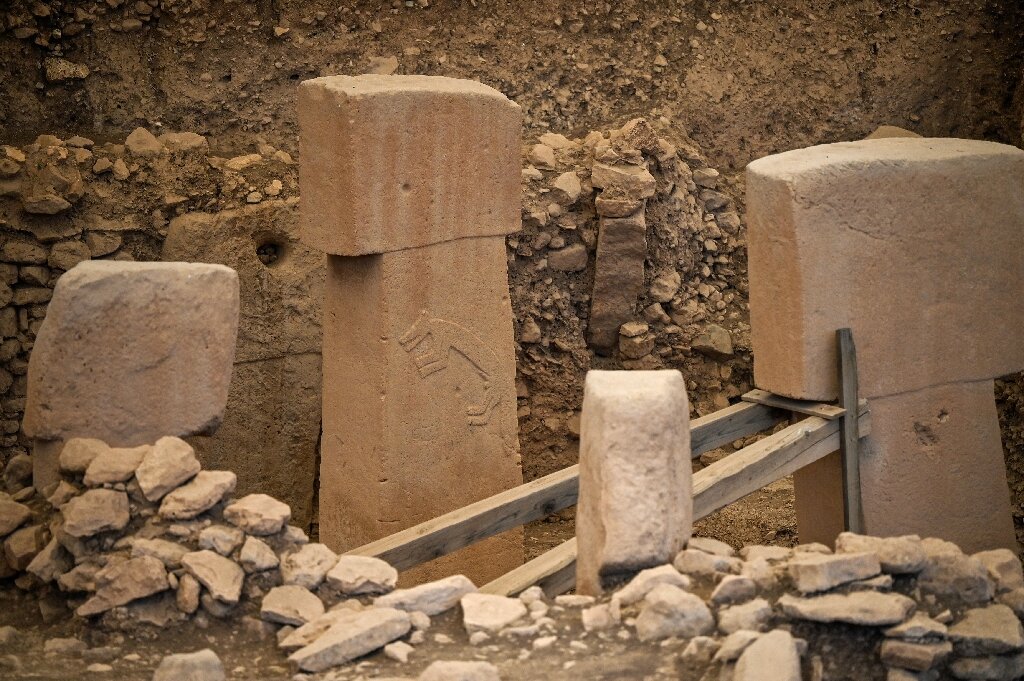
Mysterious: Carved T-shaped megaliths at the prehistoric Göbekli Tepe near Sanliurfa, Turkey.
Tucked away on a sun-splashed hillside in southeastern Turkey, the world’s oldest religious sanctuary is slowly revealing its secrets.
“When you dig a new trench you never know what’s going to happen,” said Lee Clare of the German Archaeological Institute, who has been excavating there since 2013.
“It’s always a big surprise.”
Göbekli Tepe, which means “pot-bellied hill” in Turkish, is perhaps the most important archaeological site on Earth.
More than 7,000 years before Stonehenge and Egypt’s oldest pyramids, thousands of our prehistoric ancestors gathered and worshipped around highly decorated T-shaped megalithic pillars.
“The importance of this cannot be overstated,” Sean Lawrence, an assistant professor of history at West Virginia University, told AFP.
Scholars believe that human settlement in these hills near the Syrian border began about 12,000 years ago, when groups of Stone Age hunter-gatherers came together to build the sites.
Göbekli Tepe may be part of a larger sacred complex that includes nearby hilltop ruins that some experts believe may never have been inhabited, but that archaeologists believe may be even older.
An endless mystery

Archaeologists work at Gobekli Tepe in southeastern Turkey, one of the world’s most important archaeological sites.
No one could have predicted this until German archaeologist and prehistorian Klaus Schmidt brought the first finds to the surface in 1995.
Since then, German and Turkish archaeologists have been working there in the sun, and now it’s attracting long lines of tourists wondering about its many mysteries.
It’s unclear when exactly it even began.
“It’s nearly impossible to ascertain the exact year,” Lawrence said.
“But Egypt’s oldest known site, the pyramid of Djoser at Saqqara, was built around 2700 BCE, more than 7,000 years after Göbekli Tepe.”
“This marks the end of Stone Age hunter-gatherer societies and the beginning of sedentary societies,” Lawrence added.
“There are endless mysteries surrounding this site, including how work was organized and how the site was used,” he said.

Earth Mother: One of the stone carvings discovered at the prehistoric site of Göbekli Tepe in Turkey depicts a woman giving birth.
Göbekli Tepe also inspired the Netflix sci-fi psychological thriller series “The Gift,” which focuses on the ancient inscriptions carved into its pillars.
Schmidt, who often wore a traditional white turban while excavating, puzzling over the boulders carved with images of foxes, wild boars, ducks, lizards and leopards for more than two decades until his untimely death in 2014 at the age of 61.
“Time Zero”
The site was initially thought to be purely ceremonial in nature, but Mr Clare said there was now “hard evidence” of the beginnings of a sedentary life, with several buildings similar to those from the same period found in northern Syria.
Turkey, a country not known for making the most of its vast archaeological heritage, welcomed the discovery wholeheartedly.
Artifacts from Göbekli Tepe are on display in the impressive archaeological museum in the nearest city, Şanlıurfa, which itself is very ancient and is believed to be where Abraham was born.
In fact, the new museum, built in 2015, boasts “the largest collection of Neolithic artifacts in the world,” according to director Celal Uludag: “Every portable artifact from Göbekli Tepe is on display here.”

Key attraction: Visitors take a photo at the Gobekli Tepe archaeological site near Sanliurfa, Turkey.
“This is a journey to ground zero of civilization, of time,” said Aydin Aslan, head of Sanliurfa’s Culture and Tourism Organization.
“Göbekli Tepe sheds light on prehistory, which is why it is the common heritage of humanity,” he said proudly.
“Deeper”
Last year, Turkey’s Ministry of Culture increased funding for further excavations in the area as part of the Stone Hills project, including at Karahan Tepe, a hilltop site about 35 kilometers from Göbekli Tepe that some believe may be even older.
“Gobekli Tepe is not the only archaeological site and we will now investigate it in greater depth,” Culture Minister Nuri Ersoy said last year.
“The additional funding will give us an exciting opportunity to compare our findings from Göbekli Tepe with newer sites of the same age in the Şanlıurfa region,” said Clare.
Göbekli Tepe has breathed new life into an impoverished and long-neglected region further hit by a cross-border civil war: Syrian refugees now make up a quarter of Sanliurfa’s population.

A duck sculpture carved into one of the pillars at the prehistoric Gobekli Tepe ruins in Sanliurfa, Turkey.
More than one million tourists visited Sanliurfa in 2019, and the city expects it to return to pre-pandemic levels this year.
“Today, Göbekli Tepe is starting to have a direct impact on the city’s economy,” Aslan said, adding that he hopes its glorious past will be an important part of the city’s future.
© 2022 AFP
Source: Turkish Hilltop Where Civilization Began (June 10, 2022) Retrieved June 27, 2024 from https://phys.org/news/2022-06-turkish-hilltop-civilisation-began.html
This document is subject to copyright. It may not be reproduced without written permission, except for fair dealing for the purposes of personal study or research. The content is provided for informational purposes only.


